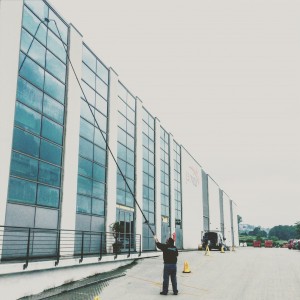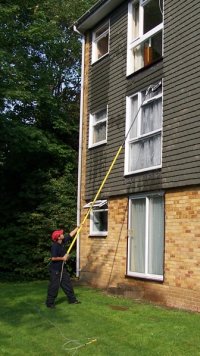Have You Considered Using a Water Fed Pole System?
If you wish to take your window cleaning business seriously and have a window cleaning round which involves some work at height, then you should at least give the idea of purchasing a water fed pole system some serious thought.
Questions you may be asking:
Is it OK to just use ladders?
What are the results like?
Is it suitable for domestic work?
How much does a system cost?
Do I need a van?

Is it OK to just use ladders?
You are no doubt aware that in 2005 new working at height regulations came into play which brought into question whether ladders should be used when cleaning windows.
“Every employer shall ensure that work is not carried out at height where it is reasonably practicable to carry out the work safely otherwise than at height.” View Source
In line with these regulations, water fed poles or even traditional extension poles are obvious alternative methods which could often be used to avoid the risk of working at height.
Controversy was sparked up when talk began of a “ladder ban”. In September of that year comments were made by the HSE which cleared up that false rumour. Ladders are not banned. The key message of the HSE is that ladders should only be used for low-risk, short duration work.
In reality many window cleaners still use ladders day in and day out as their primary method for accessing windows at height. Does that mean that it is OK for window cleaners to just use ladders?
In March 2006 the HSE made the following further comments during a seminar at the Windex trade show...
- The health and safety executive recognizes that it is unrealistic to expect every window cleaner to adopt new working practices overnight and also accepts that the indusrty accident record is low and is anticipating a period of transition to allow the industry to settle into the adoption of any new working methods needed to comply with the new regulations.
- During this period the HSE will expect all window cleaners to consider the safety benefits of using alternatives to ladders and plan to change their work practices where possible.
- The HSE will advise shortly as to the length of the transitional period.
- The following examples illustrate situations where, provided a proper risk assessment has been done and equipment is properly used, ladder use may be appropriate during the transitional period.
Situations where ladders may be suitable:
- On ground floor windows both internally and externally using ‘A’ frame ladders.
- Internal of high windows in schools, shopping malls, atriums etc.
- Up to and including 1st floor using ladders no more than 6 metres on domestic and small commercial properties.
- Removal of heavily impaced soilage. Eg. Builders Cleans
- To access windows above flat roofs.
- Where the number of windows to be cleaned at height is very small relative to the total, making use of more expensive access or cleaning methods unreasonable (eg. Less than 6 1st floor) on an isolated property.
- On city centre red routes and in other areas where you can’t get the waterfed pole van near to the building to be cleaned and trailing hoses would cause a hazard.
- On properties where the use of a trolley system is not suitable because of site conditions (i.e steps or other physical obstructions)
- On isolated domestic and small commercial premises. (i.e in rural locations where you may have, say only one two houses on a street/housing estate.
- On domestic and small commercial premises where ladders are required to access above a flat roof and there is a limited number of 1st floor windows which are not above a roof.
New health & safety legislation (WAHR) - How the window cleaner can comply with the WAHR.
Ian Greenwood - Health & Safety Executive.
The bottom line is that working from a ladder is a very risky business. Nobody goes to work in the morning expecting to fall of a ladder, but unfortunately many people do. If you use a ladder many times every day, naturally the risk of a fall is increased.
Whether you like it or not, water fed pole systems are here to stay. They offer an efficient, effective method of carrying out the same task without the risk of working at height. As a professional window cleaner, if you haven’t already done so, you would do well to consider purchasing a system.
What are the results like?
Squirting windows with pure water from a garden hose pipe attached to a telescopic pole with a brush on the end of it, may not have sounded like a very convincing idea for cleaning windows the first time you heard of it.
The thought of using no cleaning chemicals or detergents may have left you a little dubious as to what kind of results would be achieved. The fact is however, that when used properly the results achieved using a water fed pole are excellent.
As with traditional window cleaning methods, the results achieved with water fed pole systems greatly depend on the operator. Somebody new to using a squeegee will doubtlessly make mistakes, just as a novice using a water fed pole will have some teething problems. However, once you have acquired the necessary skills we can safely say that you will be very pleased with the results.
If you make a mistake with a squeegee, the result is a very obvious streak on the window. If we are honest, this even happens after years of experience. In most cases this is noticed immediately and we can correct it with the use of our scrim or microfibre cloth. Occasionally though, the light may be reflecting on the window in such a way that you don’t notice until you come to do the inside windows. When looking out of the window in certain light, the mistake is very obvious. However, it is not always the case that we clean the inside windows. We can conclude then, that traditional methods do not always produce a perfect result. Why is this relevant?
When using a water fed pole the results won’t necessarily be perfect every time either. Generally after some experience, you shouldn’t get the nasty contaminated drips coming down from the frames and air vents. From time to time though you may find that there is a certain amount of ‘spotting’ on the window.
The difference is that you would have to go close up to the window and focus on the spotting to notice it, whereas a streak left from a squeegee blade or cloth is quite obvious even from a distance.
A common myth is that water fed pole systems are no good on domestic work. The reasoning behind this may vary. Perhaps a window cleaner may worry as to whether the general household customer would accept this new window cleaning method. These reservations are valid to a certain extent. If you turn up one day with a water fed pole and give no explanation as to how it works or the reason for the change, then the chances are, some customers will object. They may be confused as to why the windows have been left dripping wet for example. However, by taking the time to introduce your customers to the concept of ladderless window cleaning these objections can be dispelled. All that is needed is a simple letter of explanation that you can deliver to the customers on your window cleaning round. Our Window Cleaning Business Stationery Templates Kit includes 2 sample letters that you can use for that purpose.
Another reason why window cleaners may state the fact that they only clean domestic properties as an obstacle to using a wfp, is perhaps the idea of having to set up all the water fed pole window cleaning equipment each time they move from house to house.

This really depends on the type of residential window cleaning round that you have. A 100 metre hose reel would reach most houses in a small Cul de Sac from a strategically parked van. Likely though, if your work is slightly scattered, the best option would be a portable trolley system. Once you have developed your water fed pole skills you will find that any extra time setting up the window cleaning equipment is more than compensated by the time gained in cleaning the windows.
How much does a system cost?
It is not our aim to sell you a particular system. There is no doubt about it, water fed pole systems can be expensive. Let’s face it though, most trades involve the purchase of at least some expensive equipment. Window cleaning has always been about as low overhead as you can get when it comes to setting up in business and so maybe we have been spoiled a little. You could be set up with a professional system for less than you may think. Check through the list of suppliers on this site and shop around for the best deals. To some extent, you get what you pay for, but remember, the aim is quite simple: to produce extremely pure water and pump it up the pole to the brush.
When buying from a supplier, ask what after sales care is provided to help you evaluate where your money is best spent. Some choose to go the DIY water fed pole system route, buying a water filtration system, a leisure battery a 60 or 100 PSI water pump and convert a sack barrow into a trolley system. For those that have the time and ingenuity to do so, this could work out even cheaper. It is quite possible however, that if you spent the same amount of time cleaning windows and earning money, as the time finding the water fed pole parts and welding the water tank cage, you probably wouldn’t be that much better off all said.
If you are hard pushed to find the money all at once, then consider leasing the equipment to spread the payments or taking out a small business loan. Once up and running you will likely find that you get through more work and so the system will soon pay for itself.
There are certain running costs and these will depend on the kind of system you use and what area you live in. If you live in an area where the water is very hard, then you will consume more DI resin than if you live in a soft water area. If you are on a meter then your water bills will increase slightly. RO units also require the filter membranes to be replaced from time to time. Ask your supplier to give you details of running costs involved for each system.
Do I need a van?
Van mount water fed pole systems are a popular choice, but not the only option. As well as trolley systems which are small enough to be put in the back of most cars, there is also the wfp trailer system which requires only a trailer and tow bar. Backpacks are also available, however these are more for infrequent use and it is not really a good idea to wear them on your back for very long, especially if you are leaning back slightly looking upwards as you work. Often backpack wfp systems are placed on the floor much like a trolley system.
The pure water for the trolley system is often stored in barrels. The usual size of these water containers is 25 litres and each barrel would last an experienced user about an hour.
If you don’t want to go the expense of purchasing a van, you can still likely operate a wfp trolley system transported in your car.
Learn more about running a window cleaning business with our list of window cleaning articles